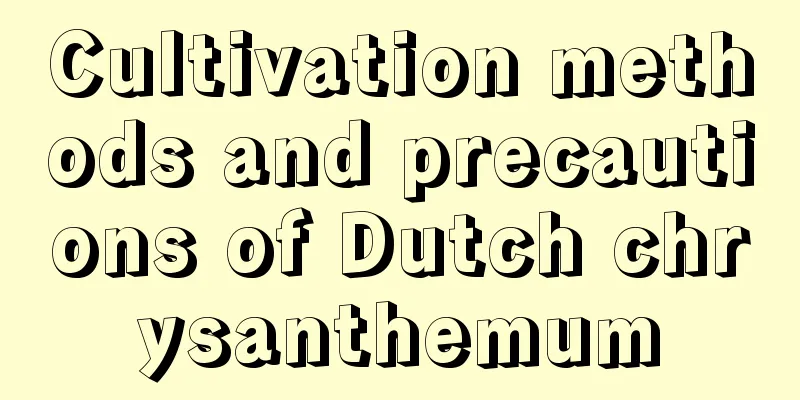Cultivation methods and precautions of Dutch chrysanthemum

|
Chrysanthemum is a very beautiful chrysanthemum with strong adaptability. It can withstand extreme heat and severe cold. Chrysanthemums prefer sunlight and grow well in dry and poor soils. If there is sufficient fertilizer during the growing period, the flowers will be more colorful. Here we talk about the cultivation methods and precautions of chrysanthemums. 1. Planting environment selection Chrysanthemums prefer an environment with plenty of sunlight and good ventilation, and are suitable for growing in soil rich in organic matter and with good drainage. If planted in a potted plant, use flower soil containing leaf mold. 2. Temperature requirements Chrysanthemum has certain temperature requirements, and the suitable growth temperature range is 15-20 degrees Celsius. Within this temperature range, chrysanthemums grow luxuriantly and bloom ideally. Too high or too low temperatures will affect the growth and flowering of chrysanthemums. If the temperature is too high, exceeding 30 degrees Celsius, it may cause problems such as poor plant growth, yellowing leaves and flower drop. When the temperature is too low, below 10 degrees Celsius, the growth rate of chrysanthemums will slow down, and bud differentiation and flowering will also be affected. Therefore, in order to ensure the healthy growth and good flowering effect of chrysanthemum, it is necessary to control the temperature of the planting environment and try to provide suitable temperature conditions. During the growing season, you can choose a place with a more stable and suitable temperature, such as a greenhouse or indoors. At the same time, during high temperatures in summer, shading measures can be taken to prevent the chrysanthemums from being exposed to strong sunlight. 3. Watering and moisturizing Chrysanthemums need to be kept appropriately moist, but not too wet. Usually water 1-2 times a week, supply an appropriate amount of moisture, and be careful to avoid waterlogging. At the same time, pay attention to moisturizing. You can spread a layer of covering (such as wheat straw) around the flower pot to reduce water evaporation. 4. Fertilization Chrysanthemums require an appropriate amount of nutrients during their growth period. You can add organic fertilizer or slow-release fertilizer to the cultivation soil and fertilize regularly to ensure that the plants get adequate nutrition. 5. Pest and disease control Chrysanthemums are susceptible to some common flower diseases and pests, such as aphids, red spiders, etc. Discover in time and take appropriate prevention and control measures, such as spraying with appropriate pesticides or manual removal. 6. Timely pruning The stems and branches of chrysanthemums will become relatively tall during their growth period and require regular pruning to maintain the plant's shape and promote bud differentiation and flowering. 7. Pay attention to the flowering period Chrysanthemums usually bloom in autumn, usually between September and November. Pay attention to observe the flowering period in time and arrange the time of fertilization and watering reasonably to ensure the fullness of the flowers and the bright colors. In summary, growing chrysanthemums requires creating suitable environmental conditions, ensuring sufficient sunlight and suitable temperature, providing adequate amounts of water and nutrients, paying attention to disease and pest control, and regular pruning and attention to the flowering period. Following the above cultivation methods and precautions can help you grow chrysanthemums successfully.
|
<<: Cultivation methods and precautions of Pyracantha bonsai
>>: Cultivation methods and precautions of lace golden dew flower
Recommend
Difference Between Foxglove and Hollyhock
1. Different plant types Foxglove is an annual or...
How often should I water Schefflera
How often should I water Schefflera Schefflera is...
How to cultivate lotus
Lotus growing conditions The best growing environ...
What to do if the branches of the fortune tree are broken
1. Pruning When you find that its branches are br...
Using rice water to water the flowers is like poison, it will kill every pot of flowers you grow!
Rice washing water There are some small broken ri...
How to grow air plants on the balcony, what should you pay attention to
1. Lighting Air plants need light during their gr...
What is the reason for the blackening of the leaves of the green radish and how to remedy it
1. Reasons for black leaves 1. The light in summe...
Is Red Sun Aquatic Plant Easy to Grow? Maintenance Methods and Precautions
Is Red Sun Aquatic Plant Easy to Grow? Red Sun Aq...
How and when to plant peas
Pea planting time and month Peas are planted outd...
Can the dried chicken manure that has been stored for a year be used (how long does it take to use the chicken manure that has been dried in the open air)
Chicken manure is a good fertilizer, even dried c...
What to do if the Begonia oleifera does not bloom
1. Temperature and light Generally, except for a ...
What vegetables are suitable to grow in January?
1. Cabbage Cabbage is one of the most common vege...
Can potassium phosphite be mixed with trace elements (taboos for compound use of potassium phosphite)
Potassium phosphite is a high-quality phosphorus ...
Scope and method of use of acetochlor
Acetochlor is a widely used herbicide . Among the...
The efficacy and function of hand ginseng
Efficacy and function This plant has high medicin...









